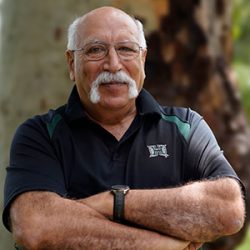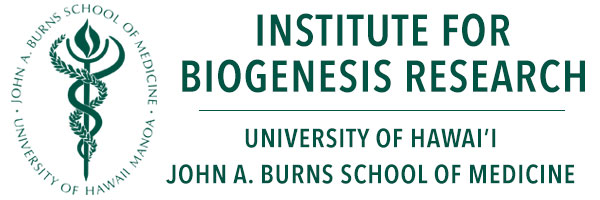Stefan Moisyadi, PhD
Associate Professor
Associate Director Dept. OB/GYN and Women’s Health

-
Affiliation:
Institute for Biogenesis Research
Department of Anatomy
Biochemistry and Physiology
John A. Burns School of Medicine
University of Hawaii -
Graduate Faculty:
Developmental and Reproductive Biology (DRB) Cell and Molecular Biology (CMB)
- Phone: (808) 956-3118
- Fax: (808) 956-7316
- Email: moisyadi@hawaii.edu
-
Address:
IBR, 1960 East-West Rd. Room E108, Honolulu, HI 96822
Transgenesis, Transfection and Gene Therapy with Transposase Enzymes
Description Of Research
My laboratory’s collaborative efforts with researchers at several domestic and international institutes were the first to propose modification of a transposon for site-specific integration and/or enhancing site-specificity. Additionally, the collaboration was first to suggest that these methods would allow for site-selective, efficient integration into an organism’s genome, whether for gene therapy or transgenic organisms. For example, transposons, such as Sleeping Beauty, and bacteriophage integrases, such as φC31, have been developed that can transform a variety of cell lines and organisms; however, they integrate the transgene they carry randomly into host genomes and we know that non-specific integration can induce cancer and also disrupt functional genes, unrelated to cancer that affect the fitness of the organism.
We and our collaborators have constructed chimeric transposases and other integrating enzymes for targeted integration and/or to enhance site-specificity. The ability to customize zinc-finger DNA binding modules will enable us to target integration events to specific locations in the genome. Such targeted integration of transgenes is essential for proper and stable levels of protein expression and to prevent integration into unwanted areas of the genome.
Why DNA based integrating vectors?
DNA constructs have many advantages over retroviruses. They are frequently in plasmid form and can be packaged non-virally, thus allowing increased stability. Furthermore, a DNA construct is preferred because the reverse transcriptase of a retrovirus has high error rates in copying both RNA and DNA due to its lacks the 3′ to 5′ exonuclease activity necessary for proofreading during DNA synthesis.
Adding new genes to mice to create new experimental models, or to human tissues for gene therapy, is an important new technology that has evolved many different ways in the past 30 years. My research focuses on a new methodology that does not employ viruses, and has the potential for site-specific integration. This means that we can not only add new genes, but replace defective ones. We have developed a new method we term Active Transgenesis that uses enzymes to facilitate the integration of new DNA into genomes. Previously, we directly compared the genomic integration efficiencies of four enzymes that integrate DNA into chromosomes, called transposases; piggyBac, hyperactive Sleeping Beauty (SB11), Tol2, and Mos1, in four mammalian cell lines. piggyBac demonstrated significantly higher transposition activity in all cell lines, while Mos1 had no activity. Furthermore, piggyBac transposase coupled to the GAL4 DNA binding domain retained trasposition activity, whereas similarly manipulated gene products of Tol2 and SB11 were inactive. The high transposition activity of piggyBac and the flexibility for molecular modification of its transposase suggest the possibility of utilizing it routinely for mammalian transgenesis and eventually gene therapy.
Much of previous gene therapy research had focused on different viral modes of gene delivery. While viruses seem well suited to deliver therapeutic genetic material, they are also effective at causing mutations on the host organism’s DNA. A significant drawback in using this form of gene therapy has been that it can trigger immune reactions or activate cancer-causing genes, with lethal consequences to the patient. The theoretical advantage of using a piggyBac, in contrast, is that the gene can be delivered safely to a specific location in the genome, where it can achieve the desired therapeutic response.
Selected Publications
- Wu Z, Xu Z, Zou X, Zeng F, Shi J, Liu D, Urschitz J, Moisyadi S, Li Z. Pig transgenesis by piggyBac transposition in combination with somatic cell nuclear transfer. Transgenic Res. 2013 Dec; 22(6):1107-18. doi: 10.1007/s11248-013-9729-0. Epub 2013 Jul 16. PubMed PMID: 23857557; PubMed Central PMCID: PMC3838457.
- Urschitz J, Moisyadi S. Transpositional transgenesis with piggyBac. Mob Genet Elements. 2013 May 1;3(3):e25167. Epub 2013 May 24. PubMed PMID: 23956948; PubMed Central PMCID: PMC3742596.
- Marh J, Stoytcheva Z, Urschitz J, Sugawara A, Yamashiro H, Owens JB, Stoytchev I, Pelczar P, Yanagimachi R, Moisyadi S. Hyperactive self-inactivating piggyBac for transposase-enhanced pronuclear microinjection transgenesis. Proc Natl Acad Sci U S A. 2012 Nov 20;109(47):19184-9. doi: 10.1073/pnas.1216473109. Epub 2012 Oct 23. PubMed PMID: 23093669; PubMed Central PMCID: PMC3511126.
- Owens JB, Urschitz J, Stoytchev I, Dang NC, Stoytcheva Z, Belcaid M, Maragathavally KJ, Coates CJ, Segal DJ, Moisyadi S. Chimeric piggyBac transposases for genomic targeting in human cells. Nucleic Acids Res. 2012 Aug; 40(14):6978-91. doi: 10.1093/nar/gks309. Epub 2012 Apr 9. PubMed PMID: 22492708; PubMed Central PMCID: PMC3413120.
- Owens JB, Mauro D, Stoytchev I, Bhakta MS, Kim MS, Segal DJ, Moisyadi S. Transcription activator like effector (TALE)-directed piggyBac transposition in human cells. Nucleic Acids Res. 2013 Oct; 41(19):9197-207. doi: 10.1093/nar/gkt677. Epub 2013 Aug 5. PubMed PMID: 23921635; PubMed Central PMCID: PMC3799441
